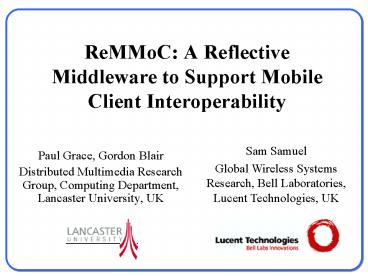ReMMoC: A Reflective Middleware to Support Mobile Client Interoperability - PowerPoint PPT Presentation
1 / 18
Title:
ReMMoC: A Reflective Middleware to Support Mobile Client Interoperability
Description:
Distributed Multimedia Research Group, Computing Department, Lancaster University, UK ... RAPP, Alice, Dolmen (CORBA) & Wireless RMI (Java RMI) ... – PowerPoint PPT presentation
Number of Views:64
Avg rating:3.0/5.0
Title: ReMMoC: A Reflective Middleware to Support Mobile Client Interoperability
1
ReMMoC A Reflective Middleware to Support Mobile
Client Interoperability
Sam Samuel Global Wireless Systems Research, Bell
Laboratories, Lucent Technologies, UK
- Paul Grace, Gordon Blair
- Distributed Multimedia Research Group, Computing
Department, Lancaster University, UK
2
Outline
- The challenges for mobile computing middleware
- Middleware heterogeneity
- The ReMMoC approach
- Reflection, components component frameworks
- A Web Services based programming model
- Evaluation
- Future work concluding remarks
3
The Challenges of Mobile Computing
- The characteristics of the mobile environment
present a number of challenges for middleware
developers. For example - Disconnection
- Low variable Bandwidth
- Address Migration
- Low Power
- Small Storage Capacity
- Middleware seeks to overcome these to better
support distributed mobile applications.
4
Mobile Computing Middleware
- Different styles of mobile middleware have
emerged to solve these challenges. - Asynchronous paradigms
- Publish-Subscribe (REBECA, STEAM)
- Tuple Spaces (LIME, L2IMBO)
- Context-based adaptation
- CHARISMA, OpenORB, Odyssey
- Enhancements to established middleware
- RAPP, Alice, Dolmen (CORBA) Wireless RMI (Java
RMI)
This explosion of middleware solutions creates
middleware heterogeneity. No interoperability
between different middleware styles.
5
A Mobile Computing Scenario
6
The ReMMoC Approach
- A Reflective Middleware to support mobile client
interoperability. - Find mobile services irrespective of the service
discovery protocol - Interoperate with services implemented by
different middleware types - Design of ReMMoC built upon four concepts
- Components (OpenCOM)
- Reflection
- Component Frameworks (CFs)
- The abstract Web Services programming model
7
The ReMMoC Architecture
8
Component Frameworks in ReMMoC
ILifeCycle
IMetaInterface
IConnections
OpenCOM component framework
ICFMetaArchitecture
CF Service Interfaces (Can be exposed interfaces
of internal components)
CF receptacles (Can be exposed)
Lock Interceptor
Graph of internal components
Validation Plug-in
9
The Service Discovery Framework
- Discover Services advertised by different
protocols. - Dynamically reconfigures itself based upon
current environment conditions. - Cycles through tests for known types of service
discovery. - Single-personality discovery performed over a
single protocol type. - Multi-personality discovery executed
simultaneously over a number of types. - Current Implementations UPnP and SLP lookup.
10
The Binding Component Framework
- Dynamic replacement of binding types
(implemented as OpenCOM components) based upon
information the from service discovery CF. - Configurations weve implemented - IIOP client,
IIOP Server, SOAP client, subscriber, publisher
11
An Abstract Programming Model Web Services
- How to program clients independently of the
changing underlying middleware? - The aim of Web Services is to allow different
service providers to implement abstract service
descriptions upon their chosen concrete
middleware binding. - WSDL language defines abstract service
descriptions. - A Client application, programmed against the
abstract WSDL definition, can interoperate with
different concrete implementations. - Hence, ReMMoC utilises the abstract service
descriptions of WSDL - Meets requirement of programming independently of
middleware. - API provides consistent information flow to the
application.
12
Our Assumptions
Client Application
Service
Concrete Middleware
ReMMoC
- Client application service Programmed against
shared WSDL description. - Understand same types
- We address mobile client side of this diagram.
13
Abstract to Concrete
WSDLOperation Name Request Response Input
Message Data Output Message Data
Binding CF
14
Mapping Paradigms to WSDL Operations
SP
SR
SR
SR
Output
Input
Input
Output
Input
RMI
SP
Output
SP
SP
SP
Content Subject Filter
Content Subject Filter
Input
SR
SR
SR
Input
SP
Output
Publish-Subscribe
Subject Filter
SP
Output
Input
Subject Filter
SP
SP
SP
Concrete message
SR Service Requestor
Abstract message
SP Service Provider
15
Evaluation - Mobile Applications
- Goal to develop a mobile application using ReMMoC
that operates in different locations exhibiting
middleware heterogeneity. - Three Applications implemented
- Jukebox, Chat Service, Sport News.
- Different locations (e.g. Office Home
Environment). - Heterogeneous discovery protocols (UPnP SLP).
- Heterogeneous binding protocols (P/S, SOAP,
IIOP). - The same application code (containing only
abstract operations) operates continuously across
different locations.
16
Evaluation Memory Capacity
- Mobile devices are resource light and reflection
is expensive why not reconfigure at the server
side?
17
Future Work
- Dynamic component downloading architecture based
upon context information. - Extension to include other binding paradigms
- Tuple spaces, data-sharing, multimedia streaming
etc. - Integration with resource management
architecture. - Evaluation using more complex applications
- Ambient intelligent environments, ubiquitous
computing. - Investigate Web Service description formats that
include non-functional aspects (e.g. Web Services
Endpoint Languages) and more complex interaction
patterns (e.g. Web Services Flow Language).
18
Concluding Remarks
- Mobile environments contain heterogeneous
middleware - ReMMoC developed to support application
developers in face of this type of heterogeneity - Reconfiguration of binding and service discovery
- Evaluated and demonstrated across a set of mobile
applications - Jukebox
- Chat service
- Sport News Service

